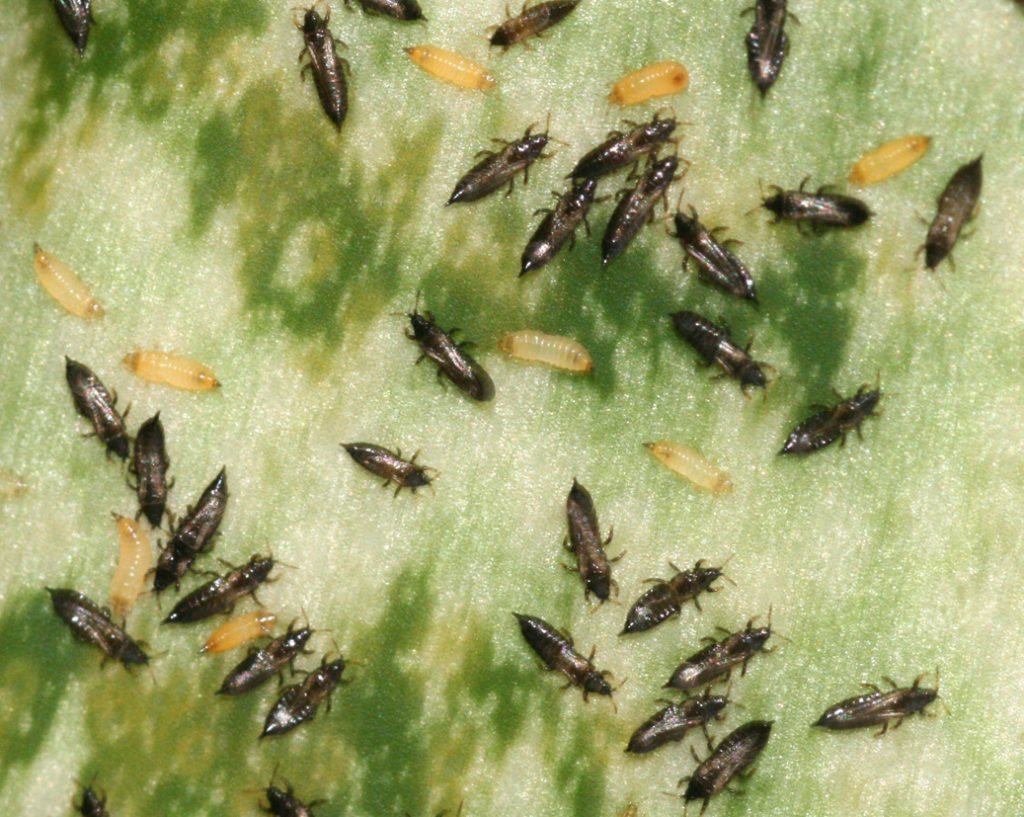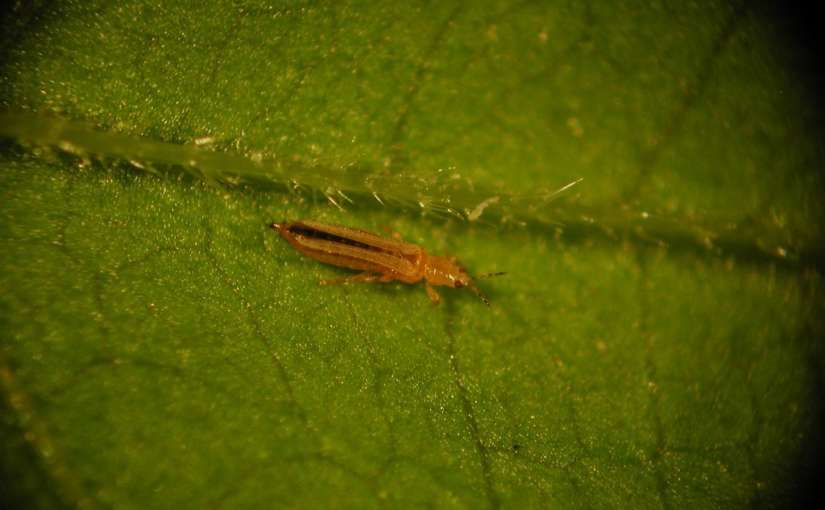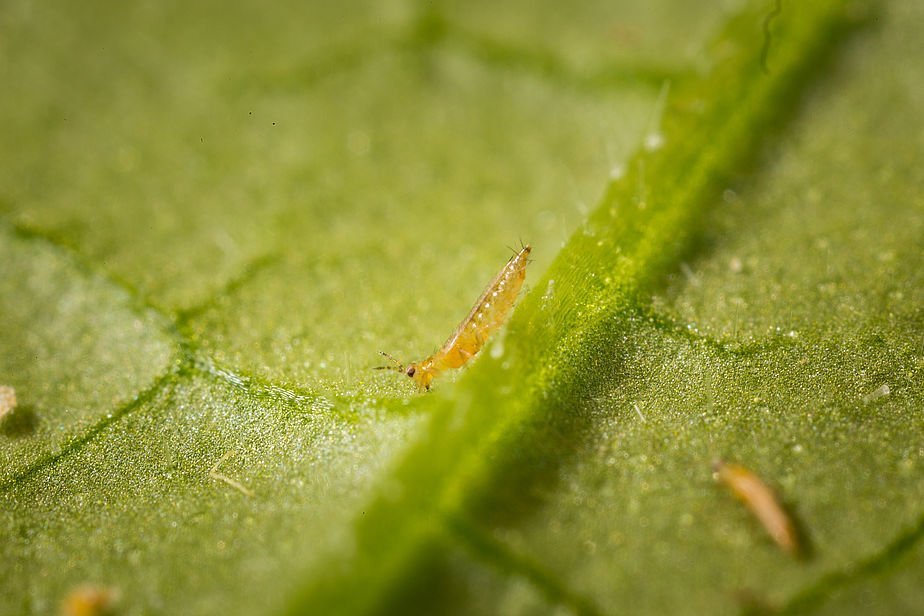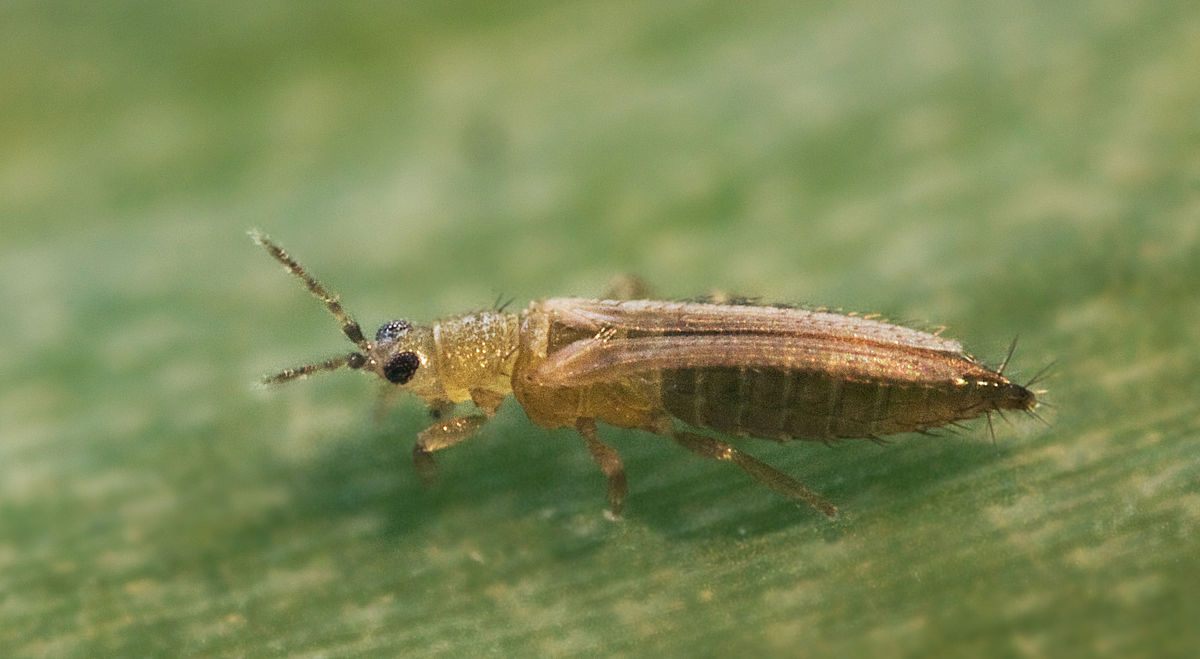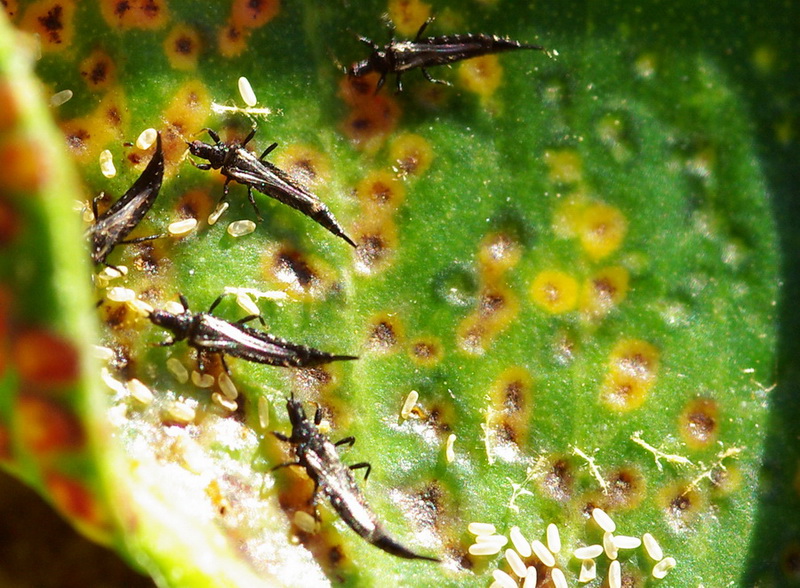Crops consist of large extensions of land manipulated by man to grow food necessary for the consumption of society; continuous contact with the environment exposes it to pests, bacteria and microorganisms that can affect and deteriorate plant species, in the following article we will learn about the Thrips Plague, an insect that deteriorates plants silently and slowly to the point of the loss of numerous crops, let us know everything about it and its impact on plant species

thrips infestation
The environment is composed of a large number of factors that interact with each other such as wind, water, plants, soil, among others; some are strictly necessary to maintain the balance of nature and the development of life on the entire planet earth. In addition, there are also conditions that can harm plant species distributed on the earth's surface, known as pests and diseases that influence numerous crops.
Pests are a set of tiny animals that have existed since prehistoric times, are found in the environment and adhere to plant species; feeding on its internal sap, highlighting that the sap is a fluid responsible for distributing minerals and water throughout the plant, feeding on it causes its deterioration, drying it and causing its death. This type of animal can affect large crops and generate large economic losses, therefore methods have been developed to conserve crops and agricultural species.
Among all these pests, the thrips should be highlighted, a winged insect that can measure one to two millimeters, they are very tiny and it is necessary to use a magnifying glass to be able to observe them, despite this, some are known that reach six millimeters . It belongs to the Thysanoptera family mainly because it is small and winged. 5600 species with different characteristics have been identified, but nine in total stand out throughout the American continent and are the most aggressive within their family.
They are brown or black in color and feed exclusively on vegetables and fungi and can even become predators of other arthropods. This type of pest is considered a great concern for crops, becoming widely observed in marijuana plants (Frankliniella Occidentalis), since mid-1986 it appeared in Almería, specifically in California, presuming that it came to the country through crops. from Holland by means of tomato seeds.
They feed on the content of the leaves, sucking with their needle-shaped mouth, forming scars on the leaves and generating deformations in their growth, leaving yellow, white or silver dots on the entire surface and even some small black dots. considered as thrips droppings. This type of insect is considered a serious pest that deteriorates plant species very slowly but spreads rapidly and makes it difficult to recover crops.
Thrips Identification
Thrips is not a type of pest that completely destroys crops, compared to some others such as the bud caterpillar or powdery mildew, which harm all crops, especially marijuana, reducing their quantity and quality. In this case, the Thrips is characterized by damaging plant species very slowly but spreading at high speed, making it difficult to exterminate it completely, for this reason the different types of Thrips must be known and identified to consider the measures to be taken. drink:
-
easy identification
Thrips insects move throughout the plant, it can be flying or jumping between the branches and leaves. Coming to stay throughout the plant, as well as the stem and the cup; becoming visualized as a small white, black or brown insect. They can be easily identified by their structure and physical form, but it is advisable to use a magnifying glass to better visualize their characteristics.
-
biting insects
Thrips are a type of insect that cannot secrete honeydew, a viscous substance rich in carbohydrates, with high viscosity and adherence when it evaporates in water. It consists of a type of molasses that is secreted by whiteflies, it is very useful to differentiate insects from each other.
-
insect bite
They can leave white or yellowish bite marks with an irregular shape and the presence of black dots (insect excrement). This type of marks is observed in the section of the leaves, another type of species the red spider affects the entire leaf or the white flies that preferentially attack the veins.
Thrips Pest Characteristics
Thrips is a very common type of insect in outdoor areas and on terraces, and can even be seen in indoor crops in spring and summer, appearing and reproducing easily during this season, but the rest of the year it affects the outdoor crops. Its reproduction is sexual or also by parthenogenesis, based on development by non-fertilized female cells, without the need for male sexual cells.
In this case, this type of reproduction is conditional, in case of parthenogenesis the female is not fertilized by the male, only female offspring will be produced, while when fertilized it will have the option of generating offspring of both sexes. Thrips females are capable of producing 30 to 300 eggs depending on the type of species; Influencing in this case the temperature and humidity for obtaining eggs.
Thrips Life Cycle
Insects are an animal species that reproduce very quickly in short periods of time, evolving and developing rapidly, most reproduce sexually, where the female lays the eggs fertilized by the male and they are formed after the necessary food; in others, asexual reproduction takes place where the young are reproduced only by the female.
Marijuana crops located outdoors, emerge in spring time, developing at warm temperatures of approximately 15ºC although they are capable of resisting up to 36ºC. On the other hand, indoor crops reach a temperature between 20ºC and 25ºC, highlighting in this case the ideal conditions for the reproduction of Trips in their crops.
The Trips stand out for passing some vital steps to develop effectively, their eggs are formed between three to five days until they hatch, then two larvae emerge in a period of approximately eight days, until they form pre-nymphs or pupae, lasting in that state for four up to five days to reach the adult phase, each of these stages is described below:
- Eggs
The eggs formed by female Thrips (sexual or asexual) are formed in their adult state, have a yellow coloration, are small in size and have the shape of a human kidney. They measure between 150 and 250 microns, the eggs are embedded in the plant tissue, mainly in the leaf section, and hatch after three or five days.
- Larvae
Known as the juvenile phase of insects, it represents a stage for the anatomical and physiological development of the species. Thrips larvae begin with a pearl gray color as they grow they acquire an ocher color, their time in this phase is approximately eight days until they reach the next stage (pupa). Despite this, within the larva phase it goes through two stages, in both cases it actively feeds by biting the leaves of the plants.
- Pupa
Considered as a young or immature state, it still does not have the sufficient development of the sexual organs and little development of its wings. In this stage, the species moves to the substrate and goes through two main stages known as prenymphs and nymphs, because they are in direct contact with the ground, even in the pupal stage they do not feed and only spend this stage by four to five days.
- Adult
Upon reaching the adult phase, the Trips come to feed again on the leaves of the plant, even reproduce and lay eggs. In this case it will depend on the gender, males usually live between 30 and 50 days and females between 40 and 75 days, in the case of female species they are capable of laying between 30 and 300 eggs depending on the conditions. environment in which they are found. The eggs can be affected by the environmental temperature and humidity, if they are higher than the ideal conditions, their mortality will increase.
Damage Caused by Thrips
Pests represent a great concern for all crops, affecting the aesthetics of the fruits and the production of plants, they represent a great concern for farmers and the conservation of crops. The Trips in their larval state absorb the sap, it represents the fluid that circulates throughout the plant and transports the nutrients throughout it; the loss of sap causes its weakening, influencing its growth and being less vigorous.
If the plant is in the process of flowering (spring and summer), the Thrips comes to delay it and reduce the volume of the shoots on the plant. This causes negative stress that influences their growth and development, which is why some plants stop growing and flower very little.
In addition, the Thrips are characterized by transmitting viruses and infections that damage plants, depending on the type of species, the Thrips of the onion (thrips Tabaci) and the Western Thrips (Frankliniella Occidentalis) where diseases and viruses known as tomato bronzing are transmitted. , causing spots on the foliage and damaging the fruits in the form of rings. Another of the diseases is tobacco mosaic (TMV) where Trips feed on pollen from the diseased plant and come into contact with another, causing deformations and generating yellow leaves.
Thrips Prevention
Pests represent a great concern for the agricultural sector because they affect crops and generate loss of essential food for society, coupled with this, generating an economic impact due to the investments made and damaging the soil in which they affect. For this reason, it is advisable to prevent pests, especially Trips, which slowly destroy crops. Here are some recommendations to avoid insect attack:
- Avoid excess nitrogen
Nitrogen is an element assimilated by plants in the form of nitrates and nitrites, they are essential for their effective growth. Sometimes there is an excess of these minerals, either due to fertilizers and applied fertilizers that oversaturate the substrate. Nitrogen attracts thrips and other pests like whiteflies.
- Stimulate the presence of natural enemies
There are natural circumstances that favor the growth of pests, which is why some ecological products that act as predators of Trips are usually applied, it is advisable to avoid toxic insecticides.
- Blue sticky traps
There are some monochrome traps, it consists of a means used to attract insects through color, allowing massive capture and identification of populations. In this case, the blue sticky traps are used, they are very effective in preventing the arrival of the adult Trips to the crops, allowing the arrival of the pest to be identified.
- Cannacure or Leaf Coat
There are other preventive options such as applying Cannacure or Leaf Coat, known as a very effective pesticide to attack pests such as Thrips, it forms a film on the surface of the leaf, this system prevents the pest from settling on the plant and also to increase his stress due to his resistance to the product, which is why he ends up moving away.
- Hygiene and Culture Conditions
It is necessary to maintain a strict control of the hygiene of the crops, especially if the plants are indoors, even the instruments used must be controlled, avoid wearing clothes that come in contact with the outside, in this way the presence of other pests.
- continuous care
The care of the plants is strictly necessary, so it is recommended to observe periodically, having a strict control of the surfaces of the leaves and the underside of the plants, looking for the presence of possible Trips eggs, bite marks, black spots or yellow or other features.
- homemade compost
In the case of using homemade compost, it represents a product made with organic materials that is subjected to biological processes that are controlled by oxidation. These types of substances are usually very rich in mineral components and beneficial for plant growth; they can be home-built with manure, making sure they are fully fermented and free of pests.
- Other products
Use materials that are harmless to plants, do not cause damage to the plant species and reduce the environmental impact. In this case, Silicate or also known as Mineral Magic (represents a mineral nutrient) stands out, Urtica a product rich in silicon that is responsible for reinforcing the epidermis and allowing it to be thicker and more resistant to attacks by pests. Diatical is a product rich in diatomaceous earth, composed of microfossils of aquatic algae and rich in nutritional components that also prevent thrips.
Eliminate Thrips in Plants in the Growth Stage
It is necessary to eliminate the Trips present in the respective crops to avoid possible crop losses and the death of plant species. The first thing to do is identify the thrips pest, and it is advisable to combat it without any delay, avoiding the possible extension of the crop. sowing; This type of plant is widely seen in marijuana crops, so measures are always taken to avoid reducing the quantity and quality of the plant.
Highlighting in this case the growth cycle of the plant, with a wide range of products that allow to eliminate Trips efficiently, it is recommended that they be applied in seasons that are not blooming or close to blooming, it is preferable to use insecticides that whether biological or chemical. Through this type of product it will be possible to grant protection to the plant and reduce the chemical attack on its tissues.
Biological Insecticides in the Growth Stage
Biological insecticides consist of a type of product that is responsible for protecting plant species from possible attacks by parasites and bacteria, eliminating insects that are undesirable in it. Normally, these types of products are made with substances that respect the environment and are friendly to plants. In this case, a biological product used for a marijuana crop stands out, the recommendations to follow are the following:
- The plague installed in the crop
In case of already having Thrips in the marijuana crop in the vegetative stage, it is recommended to spray organic pyrethrum substances, one of the most used is Spruzit, a type of product made with rapeseed oil, characterized by suffocating to insect eggs.
- Combine insecticides
It is recommended to combine some insecticides to establish natural defenses in the plant, with the main objective of generating stress in the insect, helping the plants to recover. One of the main substances used is Green Hope's Bio Protect, which is responsible for strengthening the different plants that minimize the toxins that motivate the Trips to bite the leaf.
Chemical Insecticides in the Growth Stage
It consists of a chemical compound that is used to eliminate insects and pests, allowing pest control to be carried out on insects in agriculture, allowing everything that affects human, plant and animal health to be eliminated. In case of being used to combat the Thrips of indoor crops that have been recently affected by pests such as red spider, micromite, among others; It is recommended to use Solfac Automatic Forte, working with automatic nebulizers to prevent any condition, it is necessary to avoid excessive application to avoid damage to the plant.
Eliminate Thrips in the Flowering Stage
The plants have various stages of growth and development until they reach their highest point of maturation, in the flowering phase it consists of the stage in which the flowers of the plants and their fruits emerge, normally it is during the spring and summer times. In this case, biological insecticides must be applied, since chemical insecticides tend to adhere to the plant for a long time, damaging the fruits and flowers that grow on them. In some cases, it is recommended to apply natural predators that can be easily removed from the plant species.
Biological Insecticides in the Flowering Stage
The flowering stage is considered the most beautiful and profitable of a plant, normally the crops anxiously long for this period where the desired fruits will be obtained. The flowering time is the least convenient for the development of pests, therefore it is necessary to maintain rigorous care to avoid these complications:
- Effective biological insecticides
Thrips can be combated in many ways and it is recommended to use biological insecticides, the most common being Spruzit, preferably the one with ovicide action, a potassium soap such as Mobet can also be applied, both substances can be applied alternately.
- Observe the plant every day
Daily care is necessary, using safe methods for the effective care of the plant. Care should preferably be taken of the underside of the leaves of the plant, progressively cleaning with a cotton moistened with any of the products described above, all this in order to eliminate the eggs that have been deposited or the larvae.
- reduce humidity
Maintaining a strict control of the humidity that surrounds the plant, in some cases reduces it by 40% to the point of reducing the fertility of the Thrips eggs.
Fight Thrips with Natural Predators
Natural predators are known as the natural enemies of insects and pests, in general terms they are known as those organisms that are capable of feeding on other organisms. This type of subject is able to have continuous interaction with host insect populations and regulate population levels. In the case of Thrips, they stand out as a set of natural enemies that are effective in reducing them:
- Amblyseius Cucumeris
It is a mite that belongs to a subclass of arachnids that feed on Trips eggs, even those that have hatched and are found as larvae, and can even be used as a natural enemy of red spiders. They are very common in the European continent and low temperature regions.
- Orius Laevigatus
It is known as a species of hemiptera that belongs to the Anthocoridae family, commonly known as a chiche used in Mediterranean regions. It is used by farmers to fight against insects that damage crops such as Trips and Aphids.
- Amblyseius Swirskii
It consists of a phytoseiid mite that feeds on fungi and pollen, while some feed on other mites. In this case, it stands out for consuming the eggs of the larvae of whiteflies and Thrips.
- Macrolophus caliginosus
It is known as a bug that is widely seen in the peninsular regions; considered very voracious, since it is capable of attacking whiteflies and Trips, devouring their eggs, larvae and even adult species. In some regions, strict care must be taken as they can influence like a plague.
In the marijuana crops located in the outer regions, they are obliged to use natural enemies for the conservation of the plant but with strict care since it can influence the local fauna that is adapted to its natural habitat.
General Tips
Thrips is a kind of pest that can influence numerous crops, standing out for slowly attacking and calmly deteriorating the plant, withering it to the point of death. Here are some general tips for dealing with this pest:
- easy to prevent
Thrips insects are a type of pest that is not fatal to marijuana crops, therefore, they can be easy to prevent, this type of pest can be easily identified and prevented. It is important to prevent too much time from passing as it can spread easily and make it difficult for the entire crop to recover.
- Crop Hygiene
Hygiene is a relevant factor in all the activities carried out in the life of man, in this case it is necessary to maintain adequate hygiene when treating the crop, changing clothes and shoes before moving inside.
- Preventive insecticides
There are some insecticides and pesticides that are preventive, avoiding damage to crops and deterioration of plant species, taking into account ecological and renewable factors for the conservation of crops.
We hope this article has been helpful, we leave you others that will surely interest you:

